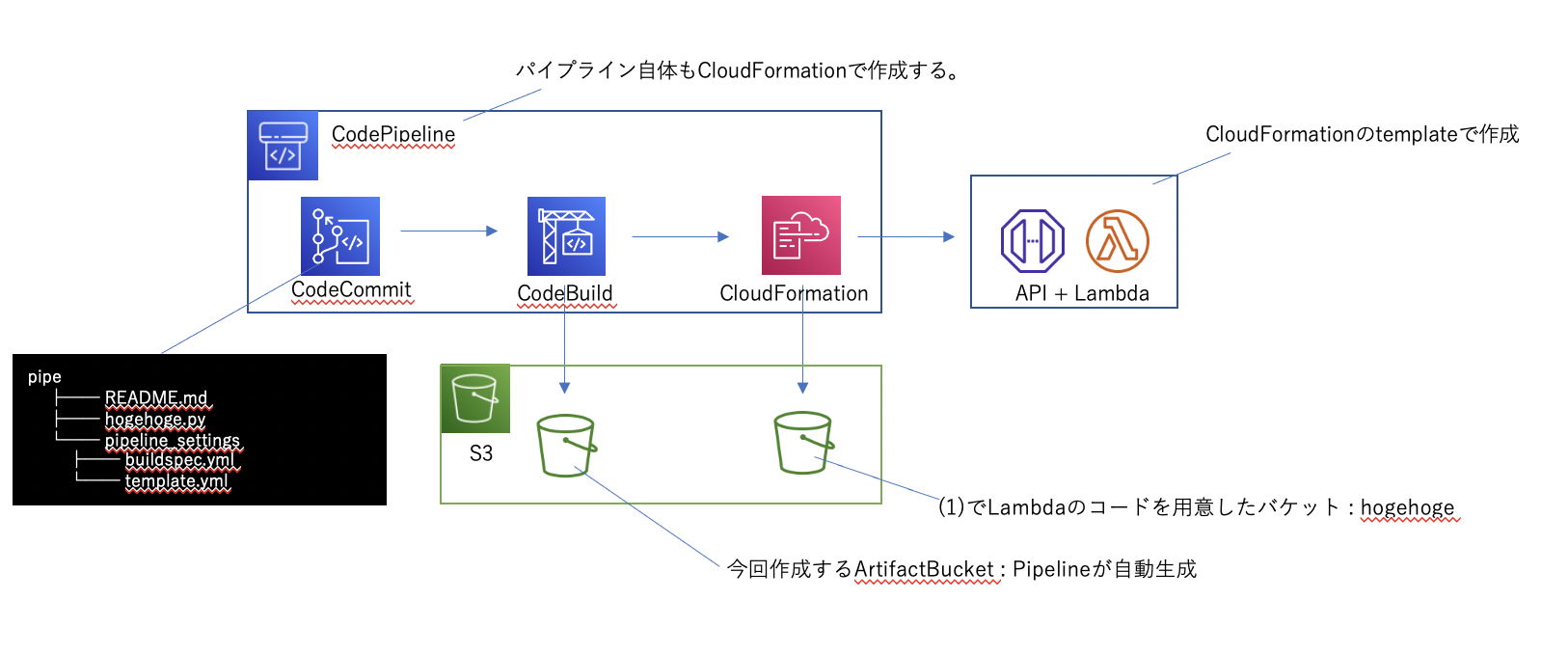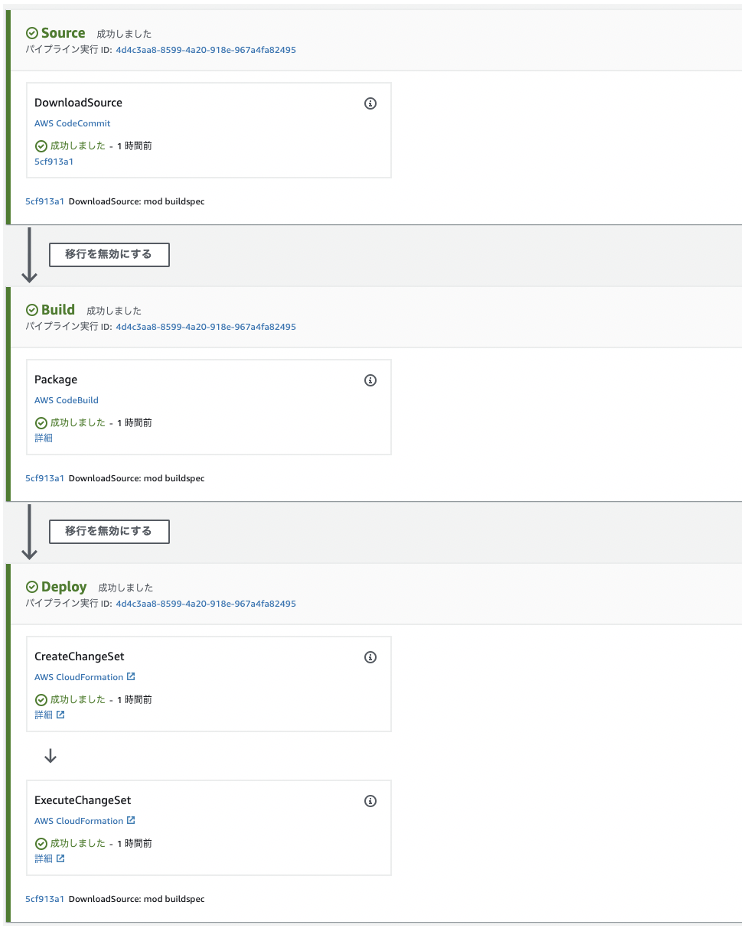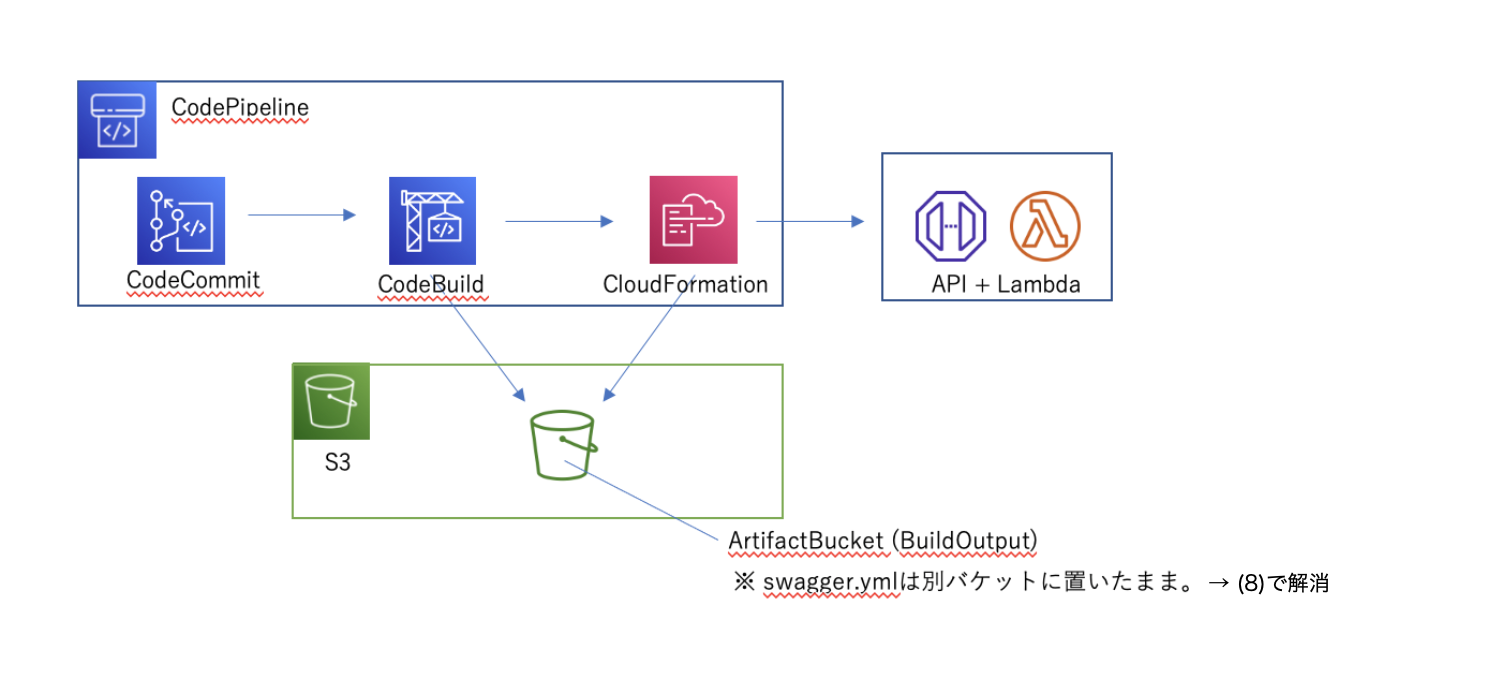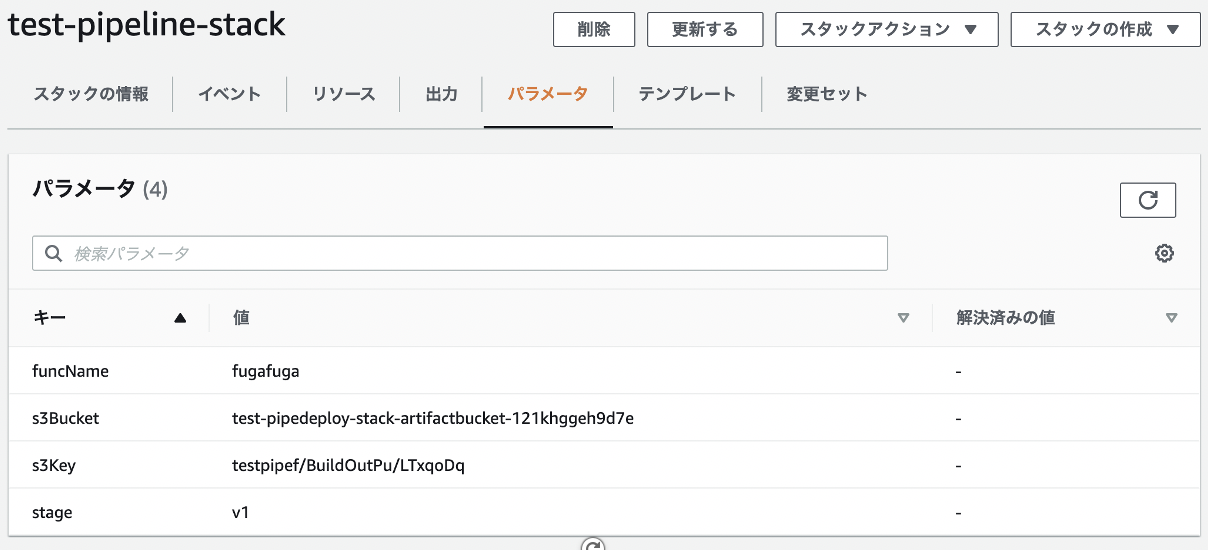CloudFormationについて知識ゼロ状態から、APIGateway+Lambda関数をデプロイするCodePipleineを組めるようになるまでの道筋を書き残します。
以下のステップで進めます。
(0) まず触ってみる : VPC作成を題材に
(1) Lambda作成
(2) IAMロール作成
(3) コードをS3に配置
(4) API Gateway作成
(5) Swaggerへ移行
(6) CICDパイプラインを作成
(7) Lambda関数のデプロイ
(8) swaggerもCICDパイプラインに乗せる。
なお開始時点の理解状況はこんな感じ
- 登場する種々のリソースはコンソールで作成/利用したことはある。
- CloudFormationが何か自体は知ってるが使ったことが無い。
- Code3兄弟は使ったことがある。
(0) まず触ってみる。
以下の記事を参考にVPCを作成してみてCloudFormationmの書き方、スタック作成/削除を学ぶ。
CFnを使ってVPCを作ってみる
● わかったこと
- template.ymlに書いた設定でリソースを作成できる。
- yamlファイルからスタックが作成され、作成するリソース郡はスタックごとに管理される。
- スタックを削除するとリソース本体も削除できる。
- スタックの作成時に設定する値はパラメータとしてymlに書いておき、CLI実行時にパラメータとして渡すことができる。
- 以下に種々のリソースを作成する時のお作法が載っている。
AWS_リソースおよびプロパティタイプのリファレンス
# 作成
$ aws cloudformation deploy --stack-name test-vpc-stack \
--template-file template.yml \
--parameter-overrides \
VpcCIDR=10.0.0.0/16
# 削除
$ aws cloudformation delete-stack --stack-name test-vpc-stack
(1) CloudFormationでLambdaを作ってみる。
arn:aws:iam::xxxxxxxxxxxx:role/fugafuga
IAM作成は今回のスコープでは無いのでLambda用のロールを事前にコンソールから作っておく。
ポリシーは空にして権限ゼロ状態。
AWSTemplateFormatVersion: "2010-09-09"
Description: >
Lambda template.
Parameters:
funcName:
Type: String
Description: >
function name.
Resources:
# Lambda関数作成
Function:
Type: AWS::Lambda::Function
Properties:
Code:
ZipFile: >
def lambda_handler(event, context):
return {
'statusCode': 200,
'body': event
}
Description: >
test cloudformation
FunctionName: !Ref funcName # 実行時にパラメータで指定
Handler: index.lambda_handler
Role: arn:aws:iam::xxxxxxxxxxxx:role/fugafuga
Runtime: python3.8
● わかったこと
Lambdaに載せるコードを指定する方法は2通り
- インラインで記述する。
- S3においての参照させる。
インラインでコードを記述する場合
-
ZipFileとつけてからコードを書く。 - ファイル名はindexに固定されるようでHandlerに"index."を付さないといけない。
- nodeかpythonにしか対応していない。
(2) IAMロールも動的に生成してみる。
参照)
https://docs.aws.amazon.com/ja_jp/AWSCloudFormation/latest/UserGuide/aws-resource-iam-role.html
(1)で生成したLambdaを実行してもCloudWatchLogsにログを書き込む権限を持っていないのでロググループもログストリームも生成できない。
試しに実行結果からログへのリンクを踏んでも存在しないとしてエラーの文言が観察できる。
そこで、AWS管理ポリシーであるAWSLambdaBasicExecutionRoleをアタッチした関数名と同名のIAMロールを生成し、Lambda作成時にアタッチする。
AWSTemplateFormatVersion: "2010-09-09"
Description: >
Lambda template.
Parameters:
funcName:
Type: String
Description: >
function name.
Resources:
# IAMロール作成
LambdaExecutionRole:
Type: AWS::IAM::Role
Properties:
AssumeRolePolicyDocument:
Version: 2012-10-17
Statement:
-
Effect: "Allow"
Principal: # 誰に権限を与えるのか
Service:
- "lambda.amazonaws.com"
Action: # 何の権限を与えるのか
- "sts:AssumeRole" # Lambdaに対して一時的な権限を発行する。
ManagedPolicyArns:
- "arn:aws:iam::aws:policy/service-role/AWSLambdaBasicExecutionRole"
RoleName: !Ref funcName # 実行時に指定
# Lambda関数作成
Function:
Type: AWS::Lambda::Function
Properties:
Code:
ZipFile: >
def lambda_handler(event, context):
return {
'statusCode': 200,
'body': event
}
Description: >
test cloudformation
FunctionName: !Ref funcName # 実行時に指定
Handler: index.lambda_handler
Role: !GetAtt LambdaExecutionRole.Arn # 上で作成したLambdaExecutionRoleのARNを取得して埋め込む
Runtime: python3.8
実行すると以下のエラーに遭遇した。
An error occurred (InsufficientCapabilitiesException) when calling the CreateChangeSet operation: Requires capabilities : [CAPABILITY_IAM]
AWS Identity and Access Management によるアクセスの制御
上記公式ドキュメントに従い、実行時にパラメータで--capabilities CAPABILITY_NAMED_IAMと指定する。
!Refの代わりに!Subを使うと文字列内に変数を埋め込むことができるらしい。
(2017年12月時点) 私的 CloudFormation ベストプラクティス
(3) コードをS3に配置する。
CloudFormationのインフラ構築用のファイルにソースコードを直書きするのはひどすぎて見てられない。コード部分を分離し、zipしてS3に配置しよう。
S3Bucketでバケット名を指定し、S3Keyでzipファイル名を指定する(拡張子まで記述)。これによりファイル名のindex固定縛りもなくなった。
https://docs.aws.amazon.com/ja_jp/AWSCloudFormation/latest/UserGuide/aws-properties-lambda-function-code.html
# Lambda関数作成
Function:
Type: AWS::Lambda::Function
Properties:
Code:
S3Bucket: hogehoge
S3Key: hogehoge.zip
FunctionName: !Ref funcName
Handler: hogehoge.lambda_handler
Role: !GetAtt LambdaExecutionRole.Arn
Runtime: python3.8
(4) API Gatewayもつける。
サーバレスあるあるなAPI Gateway → Lambda構成を作ってみる。認証もかける。
コンソールからぽちぽちしていると気づかなかったが結構いろんなリソースを生成するためCloudFormationで書くとかなり行数が増える。
- POSTメソッドでRestAPIを作成
- リソースとメソッドの作成
- 使用量プランとAPIキーの生成
- Lambdaとの紐付け(権限付与)
- ステージの作成とデプロイ
参照)
Amazon API Gateway リソースタイプのリファレンス
# API Gateway RestAPI
ApiGatewayRestApi:
Type: "AWS::ApiGateway::RestApi"
Properties:
Name: !Sub "${funcName}Api"
# API Gateway Deployment
ApiGatewayDeployment:
Type: "AWS::ApiGateway::Deployment"
DependsOn: ApiGatewayMethod
Properties:
RestApiId: !Ref ApiGatewayRestApi
# API Gateway Stage
ApiGatewayStage:
Type: "AWS::ApiGateway::Stage"
Properties:
StageName: "v1"
RestApiId: !Ref ApiGatewayRestApi
DeploymentId: !Ref ApiGatewayDeployment
# API Gateway Resource
ApiGatewayResource:
Type: "AWS::ApiGateway::Resource"
Properties:
RestApiId: !Ref ApiGatewayRestApi
ParentId: !GetAtt ApiGatewayRestApi.RootResourceId
PathPart: !Ref funcName
# API Gateway Method
ApiGatewayMethod:
Type: "AWS::ApiGateway::Method"
Properties:
RestApiId: !Ref ApiGatewayRestApi
ResourceId: !Ref ApiGatewayResource
ApiKeyRequired: True
HttpMethod: "POST"
AuthorizationType: "NONE"
Integration:
Type: "AWS"
Uri: !Sub "arn:aws:apigateway:${AWS::Region}:lambda:path/2015-03-31/functions/arn:aws:lambda:${AWS::Region}:${AWS::AccountId}:function:${funcName}/invocations"
IntegrationHttpMethod: "POST"
IntegrationResponses:
- StatusCode: 200
PassthroughBehavior: WHEN_NO_MATCH
MethodResponses:
- StatusCode: 200
ResponseModels:
application/json: Empty
# API Key
ApiGatewayKey:
Type: "AWS::ApiGateway::ApiKey"
DependsOn: ApiGatewayDeployment
Properties:
Name: !Sub "${funcName}ApiKey"
Enabled: True
StageKeys:
- RestApiId: !Ref ApiGatewayRestApi
StageName: !Ref ApiGatewayStage
# API Gateway UsagePlan
ApiGatewayUsagePlan:
Type: "AWS::ApiGateway::UsagePlan"
Properties:
ApiStages:
- ApiId: !Ref ApiGatewayRestApi
Stage: !Ref ApiGatewayStage
Quota:
Limit: 100
Period: DAY
Throttle:
BurstLimit: 10
RateLimit: 2
UsagePlanName: !Sub "${funcName}UsagePlan"
# Connect ApiGatewayKey to UsagePlan
UsagePlanKey:
Type: AWS::ApiGateway::UsagePlanKey
Properties:
KeyId: !Ref ApiGatewayKey
KeyType: "API_KEY"
UsagePlanId: !Ref ApiGatewayUsagePlan
# Lambda Permission
LambdaPermission:
Type: "AWS::Lambda::Permission"
Properties:
FunctionName: !GetAtt Function.Arn
Action: "lambda:InvokeFunction"
Principal: "apigateway.amazonaws.com"
検証
$ curl -X POST https://xxxxxxxxxx.execute-api.ap-northeast-1.amazonaws.com/v1/fugafuga
{"message":"Forbidden"}%
$ curl -X POST -H 'x-api-key:scXwN5ZHmT5Ucn8tqRxF83U6BeFBdVWG2VHknQDk' https://xxxxxxxxxx.execute-api.ap-northeast-1.amazonaws.com/v1/fugafuga
{"statusCode": 200, "body": {}}%
参考
API Gateway + Lambda のCloudFormationテンプレート
https://github.com/ropupu/apigateway-lambda-cloudformation/blob/master/apigateway-lambda-cf.yml
(5) API仕様をSwaggerに書き出す。
Lambda関数と同様にAPIの仕様は外出ししたい。
Swagger+APIGateway拡張形式でymlファイルにエクスポート(swagger.yml)しておきS3に置いて参照させることにする。
(ほんとはswagger.ymlも一から書けって話だが面倒なのでAPIGatewayコンソールから作ってエクスポートしいい感じに修正して使う)
● わかったこと
- swagger.ymlで作れるのはAPIリソースまでで、ステージは生成されない。cfnのテンプレートファイルで
Stageを構成する必要がある。 - 使用量プランやキーの生成には
Stageができたあとである必要があるのでDependsOn:で依存関係を指定する。 -
AWS::Serverless::ApiやAWS::Serverless::FunctionはSAMのテンプレートなのでcfnの中では使えない。 - swagger.ymlをzipにしてみたがエラーした。
Parameters:
funcName:
Type: String
Default: fugafuga
stage:
Type: String
Default: v1
s3Bucket:
Type: String
Default: hogehoge
Resources:
# API Gateway RestAPI
ApiGatewayRestApi:
Type: "AWS::ApiGateway::RestApi"
Properties:
Name: !Sub "${funcName}Api"
Body:
Fn::Transform:
Name: AWS::Include
Parameters:
Location: !Sub s3://${s3Bucket}/swagger.yml
# API Gateway Deployment
ApiGatewayDeployment:
Type: "AWS::ApiGateway::Deployment"
Properties:
RestApiId: !Ref ApiGatewayRestApi
# API Gateway Stage
ApiGatewayStage:
Type: "AWS::ApiGateway::Stage"
Properties:
StageName: !Ref stage
RestApiId: !Ref ApiGatewayRestApi
DeploymentId: !Ref ApiGatewayDeployment
# API Gateway Key
ApiGatewayKey:
Type: "AWS::ApiGateway::ApiKey"
DependsOn: ApiGatewayStage
Properties:
Name: !Sub "${funcName}ApiKey"
Enabled: True
StageKeys:
- RestApiId: !Ref ApiGatewayRestApi
StageName: !Ref stage
# API Gateway UsagePlan
ApiGatewayUsagePlan:
Type: "AWS::ApiGateway::UsagePlan"
DependsOn: ApiGatewayStage
Properties:
ApiStages:
- ApiId: !Ref ApiGatewayRestApi
Stage: !Ref stage
Quota:
Limit: 100
Period: DAY
Throttle:
BurstLimit: 10
RateLimit: 2
UsagePlanName: !Sub "${funcName}UsagePlan"
# Connect ApiGatewayKey to UsagePlan
UsagePlanKey:
Type: AWS::ApiGateway::UsagePlanKey
DependsOn: ApiGatewayStage
Properties:
KeyId: !Ref ApiGatewayKey
KeyType: "API_KEY"
UsagePlanId: !Ref ApiGatewayUsagePlan
---
swagger: "2.0"
info:
version: "1.0.0"
title:
Fn::Sub: "${funcName}Api"
host: "ilgcfj40u7.execute-api.ap-northeast-1.amazonaws.com"
basePath:
Fn::Sub: "/${stage}"
schemes:
- "https"
paths:
/fugafuga:
post:
produces:
- "application/json"
responses:
200:
description: "200 response"
schema:
$ref: "#/definitions/Empty"
security:
- api_key: []
x-amazon-apigateway-integration:
uri:
Fn::Sub: "arn:aws:apigateway:${AWS::Region}:lambda:path/2015-03-31/functions/arn:aws:lambda:${AWS::Region}:${AWS::AccountId}:function:${funcName}/invocations"
responses:
default:
statusCode: "200"
passthroughBehavior: "when_no_match"
httpMethod: "POST"
type: "aws"
securityDefinitions:
api_key:
type: "apiKey"
name: "x-api-key"
in: "header"
definitions:
Empty:
type: "object"
title: "Empty Schema"
参考
CloudFromationのAWS::Includeを利用してAWS SAMからインラインSwaggerを分離して管理する
CloudFormationでサイズの大きいSwaggerファイルを参照させる方法
(6) CI/CDを見据える。
参照)
CodeBuild リソースタイプのリファレンス
CodePipeline リソースタイプのリファレンス
現状だと手動でS3にファイルを置いてあげてから手動でデプロイコマンドを実行しないといけない。
CodeCommitへのGit Pushをトリガーにしてデプロイするように試みる(今回はCodeCommitリポジトリは事前にコンソールから用意した)。
$ tree .
pipe
├── README.md # 使用せず
├── hogehoge.py # 使用せず (※)
└── pipeline_settings
├── buildspec.yml
└── template.yml
※ (1)~(5)で作成したtemplate.ymlでは独自に用意したS3バケットのhogehoge.zipを参照しているので現状では参照されていない。(7)で参照できるようにする。
まずはCodePipelineを通してデプロイできるようにCloudFormationでパイプラインを作成する。(参考記事のほぼコピペ)
ローカルの任意の場所に次のymlファイルを置いてパイプラインを作成する。
AWSTemplateFormatVersion: "2010-09-09"
Resources:
ArtifactBucket:
Type: AWS::S3::Bucket
BuildProject:
Type: AWS::CodeBuild::Project
Properties:
Name: 'testbuild'
ServiceRole: !GetAtt CodeBuildRole.Arn
Artifacts:
Type: CODEPIPELINE
Environment:
Type: LINUX_CONTAINER
ComputeType: BUILD_GENERAL1_SMALL
Image: aws/codebuild/ubuntu-base:14.04
EnvironmentVariables: # buildspec.yml内で使用する環境変数。
- Name: PACKAGED_TEMPLATE_FILE_PATH
Value: 'packaged.yml'
- Name: S3_BUCKET
Value: !Ref ArtifactBucket
Source:
Type: CODEPIPELINE
BuildSpec: pipeline_settings/buildspec.yml # ルート直下にbuildspecがあるなら指定不要。
# デプロイ時のロール。面倒なので全てAdmin権限を与えておく。
PipelineDeployRole:
Type: AWS::IAM::Role
Properties:
AssumeRolePolicyDocument:
Version: '2012-10-17'
Statement:
- Effect: 'Allow'
Principal:
Service:
- 'cloudformation.amazonaws.com'
Action:
- 'sts:AssumeRole'
ManagedPolicyArns:
- 'arn:aws:iam::aws:policy/AdministratorAccess'
RoleName: 'cfnrole'
# パイプラインのロール。面倒なので全てAdmin権限を与えておく。
PipelineRole:
Type: AWS::IAM::Role
Properties:
AssumeRolePolicyDocument:
Version: '2012-10-17'
Statement:
- Effect: 'Allow'
Principal:
Service:
- 'codepipeline.amazonaws.com'
Action:
- 'sts:AssumeRole'
ManagedPolicyArns:
- 'arn:aws:iam::aws:policy/AdministratorAccess'
RoleName: 'pipelinerole'
# ビルド時のロール。面倒なので全てAdmin権限を与えておく。
CodeBuildRole:
Type: AWS::IAM::Role
Properties:
AssumeRolePolicyDocument:
Version: '2012-10-17'
Statement:
- Effect: 'Allow'
Principal:
Service:
- 'codebuild.amazonaws.com'
Action:
- 'sts:AssumeRole'
ManagedPolicyArns:
- 'arn:aws:iam::aws:policy/AdministratorAccess'
RoleName: 'buildrole'
Pipeline:
Type: AWS::CodePipeline::Pipeline
Properties:
Name: 'testpipe'
RoleArn: !GetAtt PipelineRole.Arn
ArtifactStore:
Type: S3
Location: !Ref ArtifactBucket
Stages:
- Name: Source
Actions:
- Name: DownloadSource
ActionTypeId:
Category: Source
Owner: AWS
Version: 1
Provider: CodeCommit
Configuration:
RepositoryName: 'pipe'
BranchName: 'master'
OutputArtifacts:
- Name: SourceOutput
- Name: Build
Actions:
- InputArtifacts:
- Name: SourceOutput
Name: Package
ActionTypeId:
Category: Build
Provider: CodeBuild
Owner: AWS
Version: 1
OutputArtifacts:
- Name: BuildOutput
Configuration:
ProjectName: !Ref BuildProject
- Name: Deploy
Actions:
- Name: CreateChangeSet
ActionTypeId:
Category: Deploy
Owner: AWS
Provider: CloudFormation
Version: '1'
InputArtifacts:
- Name: BuildOutput
Configuration:
ActionMode: CHANGE_SET_REPLACE
RoleArn: !GetAtt PipelineDeployRole.Arn
StackName: 'test-pipeline-stack'
ChangeSetName: 'test-pipeline-stack-changeset'
Capabilities: CAPABILITY_NAMED_IAM
TemplatePath: 'BuildOutput::packaged.yml'
RunOrder: '1'
- Name: ExecuteChangeSet
ActionTypeId:
Category: Deploy
Owner: AWS
Provider: CloudFormation
Version: '1'
InputArtifacts:
- Name: BuildOutput
Configuration:
ActionMode: CHANGE_SET_EXECUTE
ChangeSetName: 'test-pipeline-stack-changeset'
StackName: 'test-pipeline-stack'
RunOrder: '2'
version: 0.2
phases:
build:
commands:
- |
aws cloudformation package \
--template-file pipeline_settings/template.yml \
--s3-bucket $S3_BUCKET \
--output-template-file $PACKAGED_TEMPLATE_FILE_PATH
artifacts:
files:
- $PACKAGED_TEMPLATE_FILE_PATH
- pipeline_settings/*
- hogehoge.py
discard-paths: yes
$ aws cloudformation deploy --stack-name test-pipedeploy-stack \
--template-file pipeline.yml \
--capabilities CAPABILITY_NAMED_IAM
Waiting for changeset to be created..
Waiting for stack create/update to complete
Successfully created/updated stack - test-pipedeploy-stack
● わかったこと
- CodePipelineのデプロイフェーズにCloudFormationを利用できる。
- CreateChangeSetで以前のスタックとの差分を確認(新規スタックの場合は作成)し、ExecuteChangeSetでデプロイを実行する。
- pipelineのStackを先に削除するとデプロイしたStackを削除するロールが削除されるの削除の順に注意する必要あり。
https://aws.amazon.com/jp/premiumsupport/knowledge-center/cloudformation-role-arn-error/
role/{role-name} is invalid or cannot be assumed
- pipelineを作成するorリポジトリにPushすると自動でパイプラインが回りだす。(ややラグがある)
- CodePipelineによりデプロイされたStackを削除する時、中身が空でないS3バケットがあると削除に失敗するので削除してから実行する。
参考
CloudFormationでLambdaの自動デプロイ環境を構築する
https://qiita.com/is_ryo/items/0382d183f514e0d06f4d
(7) LambdaのコードをCICDパイプラインに乗せる。
詰まったのはLambdaのコードをどこから取ってくるかの指定方法。(6)ではS3のバケットを別で指定しているがCodeCommitのリポジトリにあるコードを参照してデプロイして欲しい。
CodeBuildの成果物(アーティファクト)はPipelineの中で自動生成したS3バケットに格納しているため、Pipelineの中で動的に取得する必要がある。
パラメータオーバーライドを使用することで実現できる。
参考
- [aws-codepipeline] Parameter overrides cannot use Fn::GetArtifactAtt #1588
- CodePipeline パイプラインでのパラメーターオーバーライド関数の使用
- CloudFormationでCodeBuildの出力アーティファクトを使用するにはどうすればよいですか?
- CodePipeLineを使ってLambdaへの自動デプロイ
pipeline.ymlのデプロイステージにパラメータオーバーライドを指定する。
- Name: Deploy
Actions:
- Name: CreateChangeSet
ActionTypeId:
Category: Deploy
Owner: AWS
Provider: CloudFormation
Version: '1'
InputArtifacts:
- Name: BuildOutput
Configuration:
ActionMode: CHANGE_SET_REPLACE
RoleArn: !GetAtt PipelineDeployRole.Arn
StackName: 'test-pipeline-stack'
ChangeSetName: 'test-pipeline-stack-changeset'
Capabilities: CAPABILITY_NAMED_IAM
TemplatePath: 'BuildOutput::packaged.yml'
ParameterOverrides: |
{
"s3Bucket": { "Fn::GetArtifactAtt" : [ "BuildOutput", "BucketName" ] },
"s3Key": { "Fn::GetArtifactAtt" : [ "BuildOutput", "ObjectKey" ] }
}
RunOrder: '1'
Lambdaの設定の方も一部書き換わる。
# パラメータにs3Bucketとs3keyを受け取る口を用意。
Parameters:
funcName:
Type: String
Default: fugafuga
stage:
Type: String
Default: v1
s3Bucket:
Type: String
s3Key:
Type: String
# swagger.ymlもs3Bucketを参照してしまうので一旦はs3バケットのアドレス直書きに修正しておく
Resources:
# API Gateway RestAPI
ApiGatewayRestApi:
Type: "AWS::ApiGateway::RestApi"
Properties:
Name: !Sub "${funcName}Api"
Body:
Fn::Transform:
Name: AWS::Include
Parameters:
Location: !Sub s3://hogehoge/swagger.yml
# コードの参照先を変更。
Function:
Type: "AWS::Lambda::Function"
Properties:
Code:
S3Bucket: !Ref s3Bucket
S3Key: !Ref s3Key
FunctionName: !Ref funcName
Handler: "hogehoge.lambda_handler"
Role: !GetAtt LambdaExecutionRole.Arn
Runtime: "python3.8"
上記で指定するとスタックの更新時にパラメータとして設定することができる。
コンソールで確認すると以下に反映されている。
● わかったこと
- ObjectKeyに指定される値はzipファイルになるので中の1ファイルのみを指定してLambdaに乗せるとかはできなそう。
eg.) 以下はむり。
Function:
Type: "AWS::Lambda::Function"
Properties:
Code:
S3Bucket: !Ref s3Bucket
S3Key: !Sub "${s3Key}/hogehoge.py" # これはムリ
FunctionName: !Ref funcName
Handler: "hogehoge.lambda_handler"
Role: !GetAtt LambdaExecutionRole.Arn
Runtime: "python3.8"
-
API Gatewayの方もS3を参照しているがこちらはCodeCommitからswagger.ymlを取ってくることも難しそう。出力アーティファクトはzipで固められてしまうのでswagger.ymlをtemplate.ymlにインラインで展開できない。
なお、単に以下のようにS3の参照先をコメントアウトするとpipeline_settings以下のファイルがLambda内に含まれていた。
pipelineのInputArtifactsで指定したBuildOutputの中が組み込まれるということなのだろうか?(調査していないため詳細不明)
Function:
Type: "AWS::Lambda::Function"
Properties:
# Code:
# S3Bucket: !Ref s3Bucket
# S3Key: "hogehoge.zip"
FunctionName: !Ref funcName
Handler: !Ref handler
Role: !GetAtt LambdaExecutionRole.Arn
Runtime: "python3.8"
(8) swaggerもCICDパイプラインに乗せる。
(7)ではswaggerのみ別バケットに配置していたが、これもパイプラインに載せたい。
ただ、普通に載せるとCodeBuildでzipされてしまうため、CloudFormationステージでswaggerをtemplate.ymlにインラインで展開できない。
そこでCodeBuildのセカンダリアーティファクトを利用し、swaggerの出力のみ別で定義する。
BuildProject:
Type: AWS::CodeBuild::Project
Properties:
Name: 'testbuild'
ServiceRole: !GetAtt CodeBuildRole.Arn
Artifacts:
Type: CODEPIPELINE
SecondaryArtifacts:
- Type: S3
Location: !Ref ArtifactBucket # 出力先のバケットはLambdaコードなどと同じにする。
ArtifactIdentifier: artifactswagger # buildspecに詳細を書く。
Name: swaggerfiles # 出力先のバケットのどのディレクトリに置くか
Environment:
Type: LINUX_CONTAINER
ComputeType: BUILD_GENERAL1_SMALL
Image: aws/codebuild/ubuntu-base:14.04
EnvironmentVariables: # buildspec.yml内で使用する環境変数。
- Name: PACKAGED_TEMPLATE_FILE_PATH
Value: 'packaged.yml'
- Name: S3_BUCKET
Value: !Ref ArtifactBucket
Source:
Type: CODEPIPELINE
BuildSpec: pipeline_settings/buildspec.yml # ルート直下にbuildspecがあるなら指定不要。
これに伴いBuildspecも編集する。
artifacts:
files:
- $PACKAGED_TEMPLATE_FILE_PATH
- pipeline_settings/*
- lambda_function.py
secondary-artifacts:
artifactswagger:
files:
- swagger.yml
name: swaggerfiles
discard-paths: yes
discard-paths: yes
ここまでで同じ出力先バケットにswagger.ymlを展開できているので最後にtemplate.ymlのAPI定義を更新する。
# API Gateway RestAPI
ApiGatewayRestApi:
Type: "AWS::ApiGateway::RestApi"
Properties:
Name: !Ref apiName
Body:
Fn::Transform:
Name: AWS::Include
Parameters:
Location: !Sub s3://${s3Bucket}/swaggerfiles/swagger.yml
# BodyS3Location: # インライン展開しない場合はこれ。この場合swaggerの中に動的な変数は使えない。
# Bucket: !Ref s3Bucket
# Key: swaggerfiles/swagger.yml
まとめ
$ tree -a -L 2
.
├── pipe # CodeCommitリポジトリ
│ ├── .git
│ ├── lambda_function.py
│ ├── pipeline_settings
│ │ ├── buildspec.yml
│ │ └── template.yml
│ └── swagger.yml
└── pipeline.yml
最終時点での各ファイルは以下。
一部関数名とか変更した。
最終版の各ymlファイルはここ
# パイプラインの構築
AWSTemplateFormatVersion: "2010-09-09"
Resources:
ArtifactBucket:
Type: AWS::S3::Bucket
BuildProject:
Type: AWS::CodeBuild::Project
Properties:
Name: 'testbuild'
ServiceRole: !GetAtt CodeBuildRole.Arn
Artifacts:
Type: CODEPIPELINE
SecondaryArtifacts:
- Type: S3
Location: !Ref ArtifactBucket
ArtifactIdentifier: artifactswagger
Name: swaggerfiles
Environment:
Type: LINUX_CONTAINER
ComputeType: BUILD_GENERAL1_SMALL
Image: aws/codebuild/ubuntu-base:14.04
EnvironmentVariables: # buildspec.yml内で使用する環境変数。
- Name: PACKAGED_TEMPLATE_FILE_PATH
Value: 'packaged.yml'
- Name: S3_BUCKET
Value: !Ref ArtifactBucket
Source:
Type: CODEPIPELINE
BuildSpec: pipeline_settings/buildspec.yml # ルート直下にbuildspecがあるなら指定不要。
# デプロイ時のロール。面倒なので全てAdmin権限を与えておく。
PipelineDeployRole:
Type: AWS::IAM::Role
Properties:
AssumeRolePolicyDocument:
Version: '2012-10-17'
Statement:
- Effect: 'Allow'
Principal:
Service:
- 'cloudformation.amazonaws.com'
Action:
- 'sts:AssumeRole'
ManagedPolicyArns:
- 'arn:aws:iam::aws:policy/AdministratorAccess'
RoleName: 'cfnrole'
# パイプラインのロール。面倒なので全てAdmin権限を与えておく。
PipelineRole:
Type: AWS::IAM::Role
Properties:
AssumeRolePolicyDocument:
Version: '2012-10-17'
Statement:
- Effect: 'Allow'
Principal:
Service:
- 'codepipeline.amazonaws.com'
Action:
- 'sts:AssumeRole'
ManagedPolicyArns:
- 'arn:aws:iam::aws:policy/AdministratorAccess'
RoleName: 'pipelinerole'
# ビルド時のロール。面倒なので全てAdmin権限を与えておく。
CodeBuildRole:
Type: AWS::IAM::Role
Properties:
AssumeRolePolicyDocument:
Version: '2012-10-17'
Statement:
- Effect: 'Allow'
Principal:
Service:
- 'codebuild.amazonaws.com'
Action:
- 'sts:AssumeRole'
ManagedPolicyArns:
- 'arn:aws:iam::aws:policy/AdministratorAccess'
RoleName: 'buildrole'
Pipeline:
Type: AWS::CodePipeline::Pipeline
Properties:
Name: 'testpipe'
RoleArn: !GetAtt PipelineRole.Arn
ArtifactStore:
Type: S3
Location: !Ref ArtifactBucket
Stages:
- Name: Source
Actions:
- Name: DownloadSource
ActionTypeId:
Category: Source
Owner: AWS
Version: 1
Provider: CodeCommit
Configuration:
RepositoryName: 'pipe' # CodeCommitリポジトリ名
BranchName: 'master'
OutputArtifacts:
- Name: SourceOutput
- Name: Build
Actions:
- InputArtifacts:
- Name: SourceOutput
Name: Package
ActionTypeId:
Category: Build
Provider: CodeBuild
Owner: AWS
Version: 1
OutputArtifacts:
- Name: BuildOutput
Configuration:
ProjectName: !Ref BuildProject
- Name: Deploy
Actions:
- Name: CreateChangeSet
ActionTypeId:
Category: Deploy
Owner: AWS
Provider: CloudFormation
Version: '1'
InputArtifacts:
- Name: BuildOutput
Configuration:
ActionMode: CHANGE_SET_REPLACE
RoleArn: !GetAtt PipelineDeployRole.Arn
StackName: 'test-pipeline-stack'
ChangeSetName: 'test-pipeline-stack-changeset'
Capabilities: CAPABILITY_NAMED_IAM
TemplatePath: 'BuildOutput::packaged.yml'
ParameterOverrides: |
{
"s3Bucket": { "Fn::GetArtifactAtt" : [ "BuildOutput", "BucketName" ] },
"s3Key": { "Fn::GetArtifactAtt" : [ "BuildOutput", "ObjectKey" ] }
}
RunOrder: '1'
- Name: ExecuteChangeSet
ActionTypeId:
Category: Deploy
Owner: AWS
Provider: CloudFormation
Version: '1'
InputArtifacts:
- Name: BuildOutput
Configuration:
ActionMode: CHANGE_SET_EXECUTE
ChangeSetName: 'test-pipeline-stack-changeset'
StackName: 'test-pipeline-stack'
RunOrder: '2'
version: 0.2
phases:
build:
commands:
- |
aws cloudformation package \
--template-file pipeline_settings/template.yml \
--s3-bucket $S3_BUCKET \
--output-template-file $PACKAGED_TEMPLATE_FILE_PATH
artifacts:
files:
- $PACKAGED_TEMPLATE_FILE_PATH
- pipeline_settings/*
- lambda_function.py
secondary-artifacts:
artifactswagger:
files:
- swagger.yml
name: swaggerfiles
discard-paths: yes
discard-paths: yes
AWSTemplateFormatVersion: "2010-09-09"
Description: >
Lambda template.
# パラメータにs3Bucketとs3keyを受け取る口を用意。
Parameters:
funcName:
Type: String
Default: testpipelinefunc
apiName:
Type: String
Default: testpipelineapi
stage:
Type: String
Default: v1
s3Bucket:
Type: String
s3Key:
Type: String
Resources:
# IAMロール作成
LambdaExecutionRole:
Type: AWS::IAM::Role
Properties:
AssumeRolePolicyDocument:
Version: 2012-10-17
Statement:
-
Effect: "Allow"
Principal: # 誰に権限を与えるのか
Service:
- "lambda.amazonaws.com"
Action: # 何の権限を与えるのか
- "sts:AssumeRole" # Lambdaに対して一時的な権限を発行する。
ManagedPolicyArns:
- "arn:aws:iam::aws:policy/service-role/AWSLambdaBasicExecutionRole"
RoleName: !Ref funcName # 実行時に指定
# API Gateway RestAPI
ApiGatewayRestApi:
Type: "AWS::ApiGateway::RestApi"
Properties:
Name: !Ref apiName
Body:
Fn::Transform:
Name: AWS::Include
Parameters:
Location: !Sub s3://${s3Bucket}/swaggerfiles/swagger.yml
# BodyS3Location:
# Bucket: !Ref s3Bucket
# Key: swaggerfiles/swagger.yml
# API Gateway Deployment
ApiGatewayDeployment:
Type: "AWS::ApiGateway::Deployment"
Properties:
RestApiId: !Ref ApiGatewayRestApi
# API Gateway Stage
ApiGatewayStage:
Type: "AWS::ApiGateway::Stage"
Properties:
StageName: !Ref stage
RestApiId: !Ref ApiGatewayRestApi
DeploymentId: !Ref ApiGatewayDeployment
# API Gateway Key
ApiGatewayKey:
Type: "AWS::ApiGateway::ApiKey"
DependsOn: ApiGatewayStage
Properties:
Name: !Ref apiName
Enabled: True
StageKeys:
- RestApiId: !Ref ApiGatewayRestApi
StageName: !Ref stage
# API Gateway UsagePlan
ApiGatewayUsagePlan:
Type: "AWS::ApiGateway::UsagePlan"
DependsOn: ApiGatewayStage
Properties:
ApiStages:
- ApiId: !Ref ApiGatewayRestApi
Stage: !Ref stage
Quota:
Limit: 100
Period: DAY
Throttle:
BurstLimit: 10
RateLimit: 2
UsagePlanName: !Sub "${apiName}UsagePlan"
# Connect ApiGatewayKey to UsagePlan
UsagePlanKey:
Type: AWS::ApiGateway::UsagePlanKey
DependsOn: ApiGatewayStage
Properties:
KeyId: !Ref ApiGatewayKey
KeyType: "API_KEY"
UsagePlanId: !Ref ApiGatewayUsagePlan
# Lambda Permission
LambdaPermission:
Type: "AWS::Lambda::Permission"
Properties:
FunctionName: !GetAtt Function.Arn
Action: "lambda:InvokeFunction"
Principal: "apigateway.amazonaws.com"
# Lambda関数作成
Function:
Type: "AWS::Lambda::Function"
Properties:
Code:
S3Bucket: !Ref s3Bucket
S3Key: !Ref s3Key
FunctionName: !Ref funcName
Handler: "lambda_function.lambda_handler"
Role: !GetAtt LambdaExecutionRole.Arn
Runtime: "python3.8"
---
swagger: "2.0"
info:
version: "1.0.0"
title:
Fn::Sub: "${apiName}"
basePath:
Fn::Sub: "/${stage}"
schemes:
- "https"
paths:
/aaa: # パス名
post:
produces:
- "application/json"
responses:
"200":
description: "200 response"
schema:
$ref: "#/definitions/Empty"
security:
- api_key: []
x-amazon-apigateway-integration:
type: "aws"
httpMethod: "POST"
uri:
Fn::Sub: "arn:aws:apigateway:${AWS::Region}:lambda:path/2015-03-31/functions/arn:aws:lambda:${AWS::Region}:${AWS::AccountId}:function:${funcName}/invocations"
responses:
default:
statusCode: "200"
passthroughBehavior: "when_no_match"
securityDefinitions:
api_key:
type: "apiKey"
name: "x-api-key"
in: "header"
definitions:
Empty:
type: "object"
title: "Empty Schema"
$ aws cloudformation deploy --stack-name test-pipedeploy-stack --template-file pipeline.yml --capabilities CAPABILITY_NAMED_IAM
余談
Artifactに指定したフォルダ名が10文字までしか反映されていないようにうかがえる。
改訂履歴
-
2021/01/01, 2021/05/15
ParameterOverridesのアーティファクト名の誤記。BuildOutPut→BuildOutputに訂正。 -
2021/05/15
(8)の追記。




